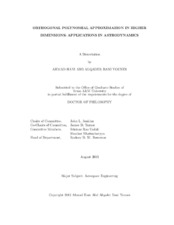| dc.description.abstract | We propose novel methods to utilize orthogonal polynomial approximation in higher dimension spaces, which enable us to modify classical differential equation solvers to perform high precision, long-term orbit propagation. These methods have immediate application to efficient propagation of catalogs of Resident Space Objects (RSOs) and improved accounting for the uncertainty in the ephemeris of these objects. More fundamentally, the methodology promises to be of broad utility in solving initial and two point boundary value problems from a wide class of mathematical representations of problems arising in engineering, optimal control, physical sciences and applied mathematics. We unify and extend classical results from function approximation theory and consider their utility in astrodynamics. Least square approximation, using the classical Chebyshev polynomials as basis functions, is reviewed for discrete samples of the to-be-approximated function. We extend the orthogonal approximation ideas to n-dimensions in a novel way, through the use of array algebra and Kronecker operations. Approximation of test functions illustrates the resulting algorithms and provides insight into the errors of approximation, as well as the associated errors arising when the approximations are differentiated or integrated. Two sets of applications are considered that are challenges in astrodynamics. The first application addresses local approximation of high degree and order geopotential models, replacing the global spherical harmonic series by a family of locally precise orthogonal polynomial approximations for efficient computation. A method is introduced which adapts the approximation degree radially, compatible with the truth that the highest degree approximations (to ensure maximum acceleration error < 10^−9ms^−2, globally) are required near the Earths surface, whereas lower degree approximations are required as radius increases. We show that a four order of magnitude speedup is feasible, with both speed and storage efficiency op- timized using radial adaptation. The second class of problems addressed includes orbit propagation and solution of associated boundary value problems. The successive Chebyshev-Picard path approximation method is shown well-suited to solving these problems with over an order of magnitude speedup relative to known methods. Furthermore, the approach is parallel-structured so that it is suited for parallel implementation and further speedups. Used in conjunction with orthogonal Finite Element Model (FEM) gravity approximations, the Chebyshev-Picard path approximation enables truly revolutionary speedups in orbit propagation without accuracy loss. | en |


